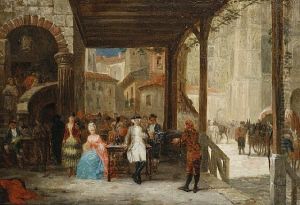Paul Amedee Greux Paintings
Paul Amedee Greux, born on December 21, 1835, in Paris, France, was a 19th-century French engraver and illustrator known for his intricate works and contributions to the world of printmaking. Greux's artistic journey began with his education at the École des Beaux-Arts in Paris, where he was trained under the tutelage of notable figures such as Léon Cogniet and Isidore-Alexandre-Augustin Pils. He honed his skills in the traditional techniques of engraving and developed a particular affinity for the etching process, which allowed him to create detailed and expressive imagery.
During his career, Greux achieved recognition for his engravings that often depicted historical and religious scenes, portraits, and landscapes. He worked on illustrations for various books and publications, showcasing his ability to convey narrative and emotion through his prints. His expertise in the craft led to his works being exhibited at the Paris Salon, where he received positive acclaim and further established his reputation as a skilled engraver.
In addition to his engravings, Greux was known for his collaborations with other artists of his time. He played a role in bringing to life the visions of painters by translating their works into prints that could be enjoyed by a wider audience. This practice was common in the 19th century, as it provided a means for artists to disseminate their works beyond the confines of galleries and private collections.
Greux's artistic output spanned several decades, during which he witnessed significant changes in the art world, including the rise of Impressionism and the beginnings of modern art. Despite these shifts, he remained dedicated to his craft, preserving the traditional methods of engraving and etching in an era of transformation.
Paul Amedee Greux passed away on February 2, 1919, in Paris. His legacy is preserved through his engravings, which continue to be appreciated by art historians and collectors for their technical mastery and historical value. Though he may not be as widely recognized as some of his contemporaries, Greux's contributions to the field of printmaking remain an important part of the artistic heritage of the 19th century.



